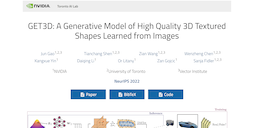User's Area

GET3D (Nvidia)
Generative 3D Textured Shapes from Images.
What is GET3D (Nvidia)?
A Generative Model of High-Quality 3D Textured Shapes Learned from Images
Advancements in the field of computer vision and graphics have led to the development of generative models capable of producing high-quality 3D textured shapes from 2D images. These models aim to bridge the gap between 2D image representations and 3D shapes, enabling the generation of realistic 3D objects with textures similar to those found in the real world. By leveraging deep learning techniques and vast amounts of training data, these generative models can accurately capture the intricate details of 3D shapes and textures, offering a wide range of applications in fields such as virtual reality, augmented reality, and computer-aided design.
Leveraging Deep Learning for Textured Shape Generation
Generative models of 3D textured shapes typically rely on deep learning architectures, such as convolutional neural networks (CNNs) and generative adversarial networks (GANs), to learn the complex mapping between 2D images and their corresponding 3D representations. Through a process known as "unsupervised learning," these models analyze large datasets of images and learn to extract salient features related to shape and texture. By capturing the underlying statistical patterns present in the training data, the generative model can then synthesize novel 3D shapes with textures that exhibit a high degree of realism and fidelity to the input images.
Real-World Applications and Implications
The ability to generate high-quality 3D textured shapes from images has profound implications for various industries and domains. In the context of virtual reality and augmented reality, these generative models enable the creation of immersive and realistic virtual environments, enriching the user experience with lifelike objects and textures. Moreover, in the field of computer-aided design (CAD), such models offer a valuable tool for rapid prototyping and digital manufacturing, allowing designers to visualize and manipulate 3D objects with realistic textures before fabrication.
Challenges and Future Directions
While generative models of 3D textured shapes have made significant strides, several challenges and opportunities for future research exist. One such challenge is the generation of high-fidelity textures and details, especially in regions of the 3D shape that are not well-represented in the training data. Additionally, ensuring the scalability and efficiency of these models for large and diverse datasets remains an ongoing area of research. Looking ahead, advancements in generative modeling techniques, coupled with the availability of increasingly rich and diverse training datasets, hold promise for further enhancing the quality and realism of 3D textured shapes generated from images.
In conclusion, the development of generative models capable of producing high-quality 3D textured shapes from images represents a significant leap forward in the fields of computer vision and graphics. These models, powered by deep learning algorithms, offer new avenues for creating lifelike 3D representations from 2D image inputs, with far-reaching implications for industries such as virtual reality, augmented reality, and computer-aided design. Despite existing challenges, ongoing research efforts promise to further refine and expand the capabilities of these generative models, paving the way for a future where realistic 3D objects and textures can be effortlessly generated from images.